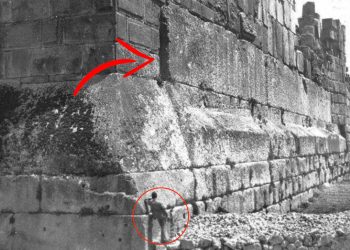Of all the problems concerning the pyramids, their construction is the most puzzling. Even Roma writer Pliny, who condemned the pyramids of Egypt as an idle and foolish display of royal wealth, found much to wonder at; “The most curious question is how the stones were raised to such great a height.”
Probably since time immemorial and even in times of ancient Egypt, people have wondered the same thing. How was it possible for an ancient civilization to erect such a massive monument thousands of years ago?
Studies of the Great Pyramid of Giza have revealed that its builders likely used more than 2.3 million stone blocks to complete the structure. Furthermore, it has been revealed that the pyramid’s stones make up a over 6 million tons structure.
Probably every visitor that has visited the Giza plateau in the past one hundred years—if not longer—has wondered how such a monument was constructed.
The imagination is staggered alone by the amount of work involved, even if the pyramid was done with modern equipment available to us today.
One must keep in mind that the ancient Egyptians constructed the pyramids with the simplest of methods; when the first pyramid of Egypt was built, the culture had no knowledge of the pulley, which was introduced in the Roman period.
Both in quarrying and building, the workers are thought to have and use copper chisels and possibly iron tools, as well as flint, quartz, and diorite pounders.
Egyptologists believe that the only additional help was large wooden crowbars and transportation of the stones, massive ships, and wooden sleds.
Egyptologist Ahmed Fakhry argues no lost technology was used in the construction of the pyramids. He writes in his book the Pyramids that, if any special skill has disappeared throughout the millennia, it is that of the overseers who worked on supervising the timing of the various operations involved in the construction of the pyramids.
It baffles my mind to think of how the pyramid was constructed and how some of the largest, heaviest stones were moved across vast distances.
Egyptologists say that the Great Pyramid builders used 5.5 million tons of limestone, 8,000 tons of granite (imported from Aswan, located some 800 kilometers away), and 500,000 tons of mortar were used in the construction of the Great Pyramid.
I find the transportation of stone across the Nile and from Aswan to Giza a fantastic yet challenging operation, and I can’t help to wonder why such trips were not recorded in ancient times. I long to know how massive stones, some of which weigh more than a dozen tons, were transported across the desert and up the Nile River.
There are illustrations on some ancient Egyptian tombs that show how some statues were transported, but this was around a thousand years after the Great Pyramid construction.
The lack of writing boggles my mind.
Fakhry, on the other hand, argues that moving blocks that weighed several tons was not considered difficult by the people who would later transport the colossus or Rameses II to the Ramesseum at western Thebes. This statue was made from one block of stone weighing likely over 1,000 tons.
Furthermore, another mind-boggling achievement was the granite obelisk’s transportation at the Temple of Karnak at Luxor. Some of these structures weigh more than 300 tons. These blocks needed to be transported from the quarries far to the south of Aswan unloaded from the ships, and set upright open their bases.
To explain the lack of records detailing how this was made, Egyptologists argue that the prices of quarrying, transporting, and erecting the monuments was such an ordinary process in ancient Egypt that they did not consider it worthy of records.
I’m afraid I have to disagree and believe that the ancient Egyptians most likely left behind records showing how this was possible, but these records have been lost.
Although we may have certain clues today that help revealed how the stones were moved from quarries to construction sites, there’s little to no knowledge when it comes to pyramid construction.
Yes, we have Merer’s Diary, but in no way does it tell us how the pyramid was built. This papyrus merely mentions how limestone was transported from Tura to Giza and that it was likely during the reign of Khufu. For all we know, these limestone blocks could have been used to repair, refurbish the pyramid or may even have been used on an entirely different construction project.
The ramp theory
So, how did the Egyptians build the pyramids? This is one of the greatest mysteries concerning the Egyptian monuments to this date. Although Egyptologists believe they’ve cracked the mystery, many enigmas remain.
A few years ago, archaeologists from the French Institute for Oriental Archaeology in Cairo and the University of Liverpool discovered a “ramp system” used to transport alabaster stones out of an ancient quarry at Hatnub in Egypt’s eastern desert.
This discovery has led many to believe that a similar method may have been used for constructing the pyramid. the ramp system was dated to around 4,500 years ago, which would place it just around when the Great Pyramid of Giza was supposedly built.
“This system is composed of a central ramp flanked by two staircases with numerous post holes,” Yannis Gourdon, co-director of the joint mission at Hatnub, explained in 2018 to Live Science.
“Using a sled which carried a stone block and was attached with ropes to these wooden posts, ancient Egyptians were able to pull up the alabaster blocks out of the quarry on very steep slopes of 20 percent or more.”
But does a ramp system from a distant quarry really offer insight into how the pyramid was built? It certainly does not, although some Egyptologists like to believe so.
The truth is that, to this date, we have not found any conclusive evidence of how the stones were transported to such heights, and there are no written records from the time of the reign of Khufu that tell us how the stones were placed into position.
Furthermore, there is no consensus among experts whether the blocks were dragged, lifted, or rolled into place.
Mark Lehner, whose book the Complete Pyramids is must-read literature for pyramid lovers, argues that the Great Pyramid was completed from start to finish in no more than a decade; this means that the builders had to place up to three blocks per minute on certain levels.
On the other hand, the Greek historian Herodotus wrote that the construction of the ramp and pyramid occupied 30 years with a workforce of 100,000 men.
Then again, Herodotus also wrote that, to build the pyramids of Egypt, the ancient builders used “machines” to allow them to raise the massive blocks of stone to great heights.
So, which one was it? Did the ancient Egyptians use ramps to move the stones up the pyramid? Did they use machines as written down by Herodotus? Or is it possible that they used another, different technique, one that we’ve not discovered to this date?
Join the discussion and participate in awesome giveaways in our mobile Telegram group. Join Curiosmos on Telegram Today. t.me/Curiosmos
Reference: Project Management B.C. / The Complete Pyramids / The Pyramids











